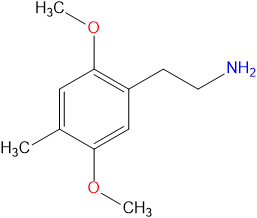Talk:2C-D/Archive 1
This page has been moved to an archived sub page in order to make room for the Flow extension.
This article is a stub. As such, it may contain incomplete or wrong information. You can help by expanding it. |
2C-D (2,5-dimethoxy-4-methylphenethylamine) is a synthetically produced psychoactive drug usually sold by online research chemical vendors. The substance itself is classed as a psychedelic phenethylamine of the 2C-x family and was first synthesized in 1970 by a team from the Texas Research Institute of Mental Sciences.[1] It was described and investigated by humans in Shulgin’s 1991 book PiHKAL: A Chemical Love Story. In his book, Shulgin lists the dosage range as being from 20 to 60 mg with many people recommending higher doses.
The drug is used recreationally for its psychedelic and entactogenic effects. Shulgin himself referred to this substance as a “pharmacological tofu,” meaning that when mixed with other substances, it can extend or potentiate their effects without coloring the experience too much. 2C-D is generally taken orally, though it may be insufflated. Insufflating tends to cause intense pain, however, and the dosage level is usually much lower. Lower doses (generally 10 mg or less) of 2C-D have been explored as a potential nootropic, albeit with mixed results.
Chemistry
Pharmacology
Subjective effects
Physical effects
The physical effects of 2C-D can be broken down into # components all of which progressively intensify proportional to dosage. These are described below and generally include:
- Blank -
- Nausea - Mild to extreme nausea is reported when consumed in moderate to high dosages and either passes once the tripper has vomited or gradually fades by itself as the peak sets in.
Cognitive effects
The head space of 2C-D is described by many as one which is relatively normal in its thought processes even at moderate to high dosages. It is often said to lack insight when compared to that of 2C-E, 2C-B and LSD.
The total sum of these cognitive components regardless of the setting generally includes:
- Blank -
Visual effects
Enhancements
2C-D presents a full and complete array of possible visual enhancements which generally includes:
Distortions
2C-D presents a full and complete array of possible visual distortions which generally includes:
Geometry
The visual geometry that is present throughout this trip can be described as more similar in appearance to that of
Hallucinatory states
Toxicity and harm potential
Lethal dosage
The toxicity and long-term health effects of recreational 2C-D use have not been studied in any scientific context and the exact toxic dosage is unknown. This is because 2C-D is a research chemical with very little history of human usage. Anecdotal evidence from people who have tried 2C-D within the psychonaut community suggests that there are no negative health effects attributed to simply trying the drug by itself at low to moderate doses and using it very sparingly (but nothing can be completely guaranteed). Independent research should always be done to ensure that a combination of two or more substances is safe before consumption.
It is strongly recommended that one use harm reduction practices when using this drug.
Tolerance and addiction potential
2C-D does not seem to be physically addictive and many users experience a self-regulating quality. There seems to be a tolerance build up when used consecutively multiple days in a row which could lead to a diminished experience. However, this effect is nearly non-existent when spaced 5-7 days apart.
Legal issues
- Canada:
- United Kingdom:
- Denmark: 2C-D has been added to the list of Schedule B controlled substances.[2]
- Sweden: 2C-D is classified as "health hazard" as of Mar 1, 2005 in their regulation SFS 2005:26, making it illegal to sell or possess.[3]
- United States: 2C-D became a Schedule I Controlled Substance in the United States as of July 9, 2012, with the signing of S. 3187 into law by President Barack Obama.[4]
See also
References
- ↑ Amphetamine analogs. II. Methylated phenethylamines | http://www.pubs.acs.org/doi/abs/10.1021/jm00295a034
- ↑ Bekendtgørelse om euforiserende stoffer | https://www.retsinformation.dk/Forms/R0710.aspx?id=137169
- ↑ Svensk författningssamling | http://www.notisum.se/rnp/sls/sfs/20050026.pdf
- ↑ Bill Text Versions 112th Congress (2011-2012) S.3187 | http://thomas.loc.gov/cgi-bin/query/z?c112:S.3187:
